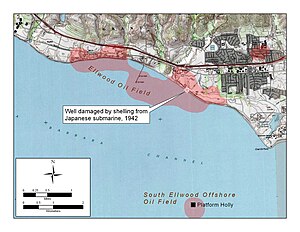Bombardment of Ellwood
| Bombardment of Ellwood | |||||||
|---|---|---|---|---|---|---|---|
| Part of World War II Pacific War and American War |
|||||||
 The Ellwood Oil Field and the location of the Japanese attack. |
|||||||
|
|||||||
| Belligerents | |||||||
|
|
|
||||||
| Commanders and leaders | |||||||
| N/A |
|
||||||
| Strength | |||||||
| N/A | 1 submarine | ||||||
The Bombardment of Ellwood during World War II was a naval attack by a Japanese submarine against United States coastal targets near Santa Barbara, California. Though damage was minimal, the event was key in triggering the West Coast invasion scare and influenced the decision to intern Japanese-Americans. The event also marked the first shelling of the North American mainland during the conflict.
Following the attack on Pearl Harbor, Hawaii, seven Japanese submarines patrolled the American West Coast. They sank two merchant ships and damaged six more, skirmishing twice with U.S. Navy air or sea forces. By the end of December, the submarines had all returned to friendly waters to resupply. However, several had gone to Kwajalein, and would pay a return visit to American waters. One of these was the Imperial Japanese Navy submarine I-17. The I-17 displaced 3,654 long tons (3,713 t) when submerged and was 365 ft 6 in (111.40 m) long. Her armament included six 20 in (510 mm) torpedo tubes and 17 torpedoes, plus a 14-cm deck gun. She carried 101 officers and men, captained by Commander Kozo Nishino.
A naval reserve officer, Nishino commanded a merchant ship which sailed through the Santa Barbara Channel before the war. His ship had once stopped at the Ellwood Oil Field to take on a cargo of oil. Unfortunately, while walking to a welcoming ceremony, Nishino tripped and fell into a patch of prickly pear cactus (now below Fairway 11 of the Sandpiper Golf Course). A group of oil workers saw the Japanese officer having cactus spines pulled from his backside and began to laugh. As a result, Nishino chose the oil field as the target for his deck gun. Most of the damage he inflicted was within 300 m (980 ft) of the spot he had fallen.
...
Wikipedia
